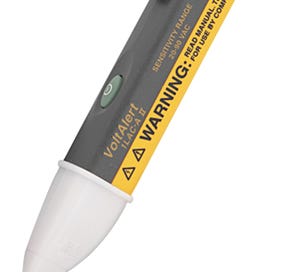50 to 30-amp hookup dangers (Rerun)
Is voltage detected in extension cord with a NCVT dangerous?
Hey Mike,
I have enjoyed your J.A.M. articles over the past couple of years and found them to be very informative and helpful. I was quite interested in your 'hot skin' video, purchased a Fluke voltage detector and tested my Lance 2465 travel trailer. Fortunately, there was no evidence of a 'hot skin' condition on any -metal in the RV or stairs, but to my surprise the extension cords and adapters detected voltage!
The extensions are connected as follows: 50-amp outlet to a Watchdog surge protector to a 50/30amp adapter to a 30-amp 50' cord to a 30/50-amp adapter to the RV 50-amp cord. Voltage was detected on the 30-amp extension cord, both adapters, RV 50-amp cord and screw at the point of connection to the RV.
Is this condition caused by dropping from 50 to 30 and back to 50-amp? Is this a condition to be concerned about?
Thank you, - Charlie K
Charlie,
Actually, that’s exactly how all Non-Contact Voltage Testers are supposed to work. Yes, they will detect a voltage when pointed close to an extension cord as you describe. I’m the guy who figured out you could use a NCVT to discover a hot-skin voltage, but the outlet and extension cord testing is what they were designed to do. Here’s a video of me demonstrating a dual-range Southwire NCVT which I really like.
Danger, Will Robinson
However, if I’m reading your connection description properly, by inserting a 30-amp extension cord in the middle of the run between a 50-amp outlet on the pedestal and the 50-amp inlet on your RV, you’ve created a very dangerous fire hazard. There’s nothing to stop you from exceeding 30-amps of total current draw in your RV, and the pedestal will happily supply more than 30 amps without tripping the 50-amp circuit breaker. So you could easily pull up to 50-amperes of current in that 30-amp rated cord which could start a fire in that extension cord or one of the 30/50 or 50/30-amp adapters.
50 to 15-amp adapters can be REALLY dangerous!
I’ve also had a few readers who stepped a 50-amp pedestal outlet down to a 15-amp extension cord, then stepped it back up to a 50-amp RV inlet. That’s WAY more dangerous since a 15-amp extension cord with just 30-amps of current can easily reach the boiling point of water in 5 minutes. Here’s a video I made a while ago demonstration this.
If you did have a fire, and an inspector (and your insurance company) looked at the connection, they might refuse to honor a claim.
Please let me know if I’m misreading your description, but if not then I recommend you plug into a 30-amp pedestal outlet, or use a 50-amp extension cord (yes, I know they’re heavy).
Let’s play safe out there - Mike







Excellent watch out situation. I've responded to many fires which had undersized wiring as the cause.
Instead of electricity, exchange voltage to moisture. So, Instead of your non contact voltage tester, you have a moisture meter. When you test the outside of your camper, or the wood inside, you want the meter to NOT detect any moisture. But, if you put the meter over a drain or the potable tank fill opening with the cap removed, you want that meter to show a moisture reading. Even though you have moisture detected in the drains and tank openings, your RV is safe from the destructive nature of moisture... meaning mold. So it's ok to detect voltage in the power cords and outlets but, not on metal doors of refrigerators, ranges or metal parts of the camper.